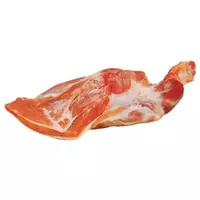Mutton

Many nationalities use lamb in national cuisines, but this meat is especially appreciated among the peoples of the East, where famous dishes are prepared from it, such as beshbarmak, shurpa, pilaf, manta, kebab. Today, lamb's nutritional properties are widely used for a variety of stew and roast dishes, broths and soups. The calorie content of lamb is relatively low and amounts to 209 kcal per 100 grams of meat.
Despite the fact that this type of meat is perfectly combined with spicy sauces, apricots, dates and sweet wine are often added to it in the East. Thanks to a variety of spices, you can emphasize the rich taste of lamb by adding zira, oregano, thyme or marjoram. Various vegetables serve as a suitable side dish for lamb: for example, potatoes can reveal the advantages of fried meat, and legumes and sour sauces emphasize the juiciness of the stew. When preparing lamb dishes, it is very important to choose the right meat: it is best to take young lamb under 3 years old. Do not forget that the color of lamb should be light red, because the older the animal, the darker the meat.
Lamb benefits
First of all, the benefit of lamb is its high protein content, which is almost identical to the content of this nutrient in pork. The amount of fat in lamb is not much higher than in other types of meat, due to which it is referred to as healthy foods.
It has been scientifically proven that the benefits of lamb for human health are beyond doubt, as it contains a large amount of vital substances and trace elements such as iodine, sulfur, chlorine, potassium, sodium, iron, magnesium, cobalt, manganese and many others. Also, this type of meat is rich in vitamins of group B. All these macro and trace elements are simply necessary for the body to maintain normal functioning. But in terms of iron content, lamb is superior to many types of meat and is comparable only to venison. This beneficial property of lamb makes it an important food in the diet of people with anemia, thanks to the ability to improve blood composition.
Mutton harms
When abusing lamb, in general, like any other type of meat, we can talk about possible unpleasant consequences that manifest themselves in the development of certain diseases, for example, sclerosis and obesity. The harm of lamb can affect both people suffering from arthritis and elderly people. This is directly related to the property of lamb to accumulate bacteria that not only increase the development of arthritis, but also negatively affect the human body as a whole.
lamb 209 kCal
Energy value of lamb (Ratio of proteins, fats, carbohydrates - ju):
Proteins: 15.6 (~ 62 kCal)
Fats: 16.3 (~ 147 kCal)
Carbohydrates: 0 g (~ 0 kCal)
Energy ratio (bj | y): 30% | 70% | 0%
 Español
Español Français
Français Português
Português Русский
Русский 简体中文
简体中文 繁體中文
繁體中文 日本語
日本語 한국어
한국어 العربية
العربية Türkçe
Türkçe Қазақ
Қазақ Deutsch
Deutsch Italiano
Italiano Українська
Українська
